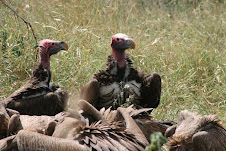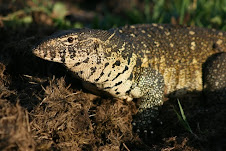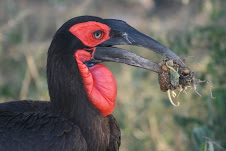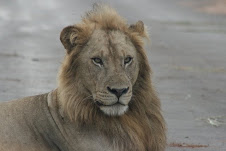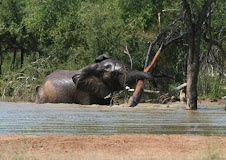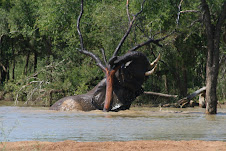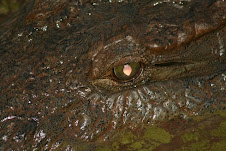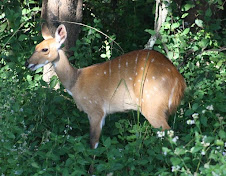Friday, 31 December 2010
SCORPION Owwwwww.!
On Monday I pulled a muscle in my back and then one of the social wasps decided it didn’t like me and stung me in the back. I have recovered from these now but on Tuesday night just before going to bed a small scorpion decided to have a go as well. I was watching a DVD when all of a sudden there was a sharp sting on my second toe on my left foot. Sh......t!!! I looked down to see a scorpion about 30mm long. Not wanting to be stung again he got the order of a size 11 boot. It was a strange sensation and one that I don’t want to go through again. There was no swelling or redness but I could feel the poison very slowly affecting my toe, and then it spread very slowly around my foot. It wasn’t really painful but as if the poison was like little explosions in my veins. Although I have never had Ricicles in my blood it was a bit like having them in your veins and them popping as the moved around. Can anyone explain what was happening. It was a bit worrying at first because I know some scorpions are deadly but luckily this one was apparently quite mild. I have read various articles on scorpion stings, about applying hot or cold water but decided to let it run its course until morning when if it didn’t improve I would go to the hospital. I collected the dead scorpion to keep for identification just in case things got worse. In the morning I talked to some of the locals and described what had happened and they told me not to worry and that the effects would wear off over a couple days and that they get stung every so often and have no after effects. They were right as today is Friday and all of the effects have now totally disappeared.
HARTMANN'S OR BURCHELL'S ZEBRA?


All is going well here in Kasungu. It has been a good week for game viewing and I have seen much of what is to be seen here including a small herd of elephants that came by the house, hippo, buffalo, Sable, Roan, zebra, hartebeest, reed buck, puku, common duiker, grysbok, vervet monkey, baboon and wart hog. I have pictures of elephant, bush pig and civet on the cameras and there have been reports of 5 wild dog 2 days ago. A builder that visits the park regularly also told me she had seen 2 prides of lion back in October. One pride consisted of 1 male, 4 females and a cub and the other was 1 male, 1 female and a cub. I assume these were the same lions as they were in the same area and only a few days apart. However it is good news as this demonstrates that they are still around and in some numbers. I have seen spoor of leopard but no actual sightings. Hyaena regularly come near to the house and can be heard ‘whooping’ away.
A couple of South Africans came to the park other day, Leon and Debbie, and stayed for 3 nights. We went for a drive and saw zebra. Although we saw some which were definitely Burchell’s zebra we also saw a small herd that might have been Hartmann’s zebra. Their face was different and had ‘reddy brown’ hair around the muzzle as well as the stripes looking different to the Burchell’s. If there are any experts out their please take a look at the photos and let me know what you think. If I get clearer pictures Ill post them when I can.
A couple of South Africans came to the park other day, Leon and Debbie, and stayed for 3 nights. We went for a drive and saw zebra. Although we saw some which were definitely Burchell’s zebra we also saw a small herd that might have been Hartmann’s zebra. Their face was different and had ‘reddy brown’ hair around the muzzle as well as the stripes looking different to the Burchell’s. If there are any experts out their please take a look at the photos and let me know what you think. If I get clearer pictures Ill post them when I can.
Saturday, 11 December 2010
MOZAMBIQUE SPITTING COBRA

When I came across this Mozambique spitting cobra it was head to head with a hamerkop in the near empty swimming pool at the lodge. The bird was after the tadpoles and the snake after the toads.
It can get out of the pool by climbing the ladder but I put a log into the pool for it to use to climb out of the pool. The workers came to see the snake and most were petrified by it. They say they are evil? This one was around 5 feet long so it must have been about fully grown and in really good condition. Other snakes I have seen recently are the Rhombic night adder, the spotted bush snake, python and the striped bellied sand snake.
It can get out of the pool by climbing the ladder but I put a log into the pool for it to use to climb out of the pool. The workers came to see the snake and most were petrified by it. They say they are evil? This one was around 5 feet long so it must have been about fully grown and in really good condition. Other snakes I have seen recently are the Rhombic night adder, the spotted bush snake, python and the striped bellied sand snake.
I decided to remove the snake from the pool last night as the water was quite cold and I had a feeling that the night watchman was going to kill the snake. I got quite a long stick and gently removed the cobra onto the grass beside the pool. I have never seen a Malawian run so fast! The snake disappeared in one direction and the man in the other.
Wednesday, 8 December 2010
LIFE GOES ON IN PARADISE
The rains are really setting in here now and the dambo is filling up again. This is good for the wildlife as it means they can find clean water everywhere however it is bad for animal viewing because it is difficult to get around the park and also means that the under growth is growing fast. A lot of animals that have been hiding under ground come out when the rains come so I expect to see spiders, frogs and snakes over the next few weeks.
The land rover is running well however when I did the shopping yesterday, 130km round trip, there was no fuel in town. How people make a living out here I don’t know as it can be very difficult to travel.
The solar panel for my electricity is ok but when the clouds come and it rains it doesn’t charge up the battery for the computer or camera batteries and although there is loads of water in the dambo the solar pump doesn’t work efficiently so the main storage tanks are low so there is a shortage of water to the houses. This also means the shower doesn’t work due to lack of water and wouldn’t be hot anyway due to lack of sun shine.
I have recently got more pictures of another leopard and also hyenas whose home ranges are about 30 km from the other leopards and hyenas that I have encountered. There have been no new sightings of the wild dogs and no reports of lion or cheetah anywhere.
The civet, bush pig and hippo turn up on my cameras regularly and last week, after trying to get his picture for 3 weeks, I finally got a video of the water mongoose that scours the fringes of the dambo most nights.
Yesterday one of the young fish eagles got a bit close to the water, while fishing, and ended up having to swim to the shore. The spur winged geese that where close by saw this as an opportunity for revenge and chased him across the lake. I am not quite sure what they would do if they really wanted to impose some damage upon him.
The land rover is running well however when I did the shopping yesterday, 130km round trip, there was no fuel in town. How people make a living out here I don’t know as it can be very difficult to travel.
The solar panel for my electricity is ok but when the clouds come and it rains it doesn’t charge up the battery for the computer or camera batteries and although there is loads of water in the dambo the solar pump doesn’t work efficiently so the main storage tanks are low so there is a shortage of water to the houses. This also means the shower doesn’t work due to lack of water and wouldn’t be hot anyway due to lack of sun shine.
I have recently got more pictures of another leopard and also hyenas whose home ranges are about 30 km from the other leopards and hyenas that I have encountered. There have been no new sightings of the wild dogs and no reports of lion or cheetah anywhere.
The civet, bush pig and hippo turn up on my cameras regularly and last week, after trying to get his picture for 3 weeks, I finally got a video of the water mongoose that scours the fringes of the dambo most nights.
Yesterday one of the young fish eagles got a bit close to the water, while fishing, and ended up having to swim to the shore. The spur winged geese that where close by saw this as an opportunity for revenge and chased him across the lake. I am not quite sure what they would do if they really wanted to impose some damage upon him.
PARADISE FLYCATCHER

I managed to get some really good photos of the paradise flycatcher making their nest near to one of the houses. This is the male building the nest. Also close to the lodge there is a nest with 2 chicks in. It looks like the mother feeds the chicks as the father cannot be seen.
STORY OF THE MATONDO




STORY OF THE MATONDO (Mopany Worm)
The moths that lay these eggs are 2 of the emperor moths. Shortly after laying several hundred eggs they hatch into caterpillars as seen below. The green caterpillar is locally caleed the Matondo and the spiky one is called the Vilungulungu. These grow incredibly quickly and can strip a 5 metre Julbernadia Globiflora tree of all of its leaves in a day. The local people from the camp and the local villages are allowed to harvest these caterpillars and in one day alone they collected in the region of 25,000kg. The caterpillars are placed in water for a couple of hours to kill them and then their insides are squashed out of them. If they are dried whole they are very bitter. They are then washed again and boiled until they change colour. They are then placed in the sun on mats to dry and then they can be eaten. Most will be re-cooked as a relish. Many of the dried caterpillars can be found for sale in the local market and can fetch about MK100 (40p) per cup full.
The darker and spiky caterpillars are considered more of a delicacy as most people don’t like collecting them because of their spikes.
Although a rough idea of numbers of the caterpillar collected are known the environmental impact has never been estimated. There are millions of caterpillars left each year to turn into moths and the trees do not seem to be damaged as they flourish in the park.
The other evening I had around 30 of the moths flying around in my house and most evenings I get various types of praying mantid, beetles, moths and stick insects. There are several geckos that run around all night long eating the smaller flies. It is fascinating to see then run across the ceiling. At the same time a large toad came visiting who presumably wanted to join in the feast. In the morning most are dead so I need to sweep up.
The moths that lay these eggs are 2 of the emperor moths. Shortly after laying several hundred eggs they hatch into caterpillars as seen below. The green caterpillar is locally caleed the Matondo and the spiky one is called the Vilungulungu. These grow incredibly quickly and can strip a 5 metre Julbernadia Globiflora tree of all of its leaves in a day. The local people from the camp and the local villages are allowed to harvest these caterpillars and in one day alone they collected in the region of 25,000kg. The caterpillars are placed in water for a couple of hours to kill them and then their insides are squashed out of them. If they are dried whole they are very bitter. They are then washed again and boiled until they change colour. They are then placed in the sun on mats to dry and then they can be eaten. Most will be re-cooked as a relish. Many of the dried caterpillars can be found for sale in the local market and can fetch about MK100 (40p) per cup full.
The darker and spiky caterpillars are considered more of a delicacy as most people don’t like collecting them because of their spikes.
Although a rough idea of numbers of the caterpillar collected are known the environmental impact has never been estimated. There are millions of caterpillars left each year to turn into moths and the trees do not seem to be damaged as they flourish in the park.
The other evening I had around 30 of the moths flying around in my house and most evenings I get various types of praying mantid, beetles, moths and stick insects. There are several geckos that run around all night long eating the smaller flies. It is fascinating to see then run across the ceiling. At the same time a large toad came visiting who presumably wanted to join in the feast. In the morning most are dead so I need to sweep up.
Saturday, 20 November 2010
32 ELEPHANT

Not much to report so far this month. We have had no new sightings of the dogs, leopard, cheetah etc.
As the water in the park dries up the elephant are coming more and more to the dam to drink. Yesterday we had this herd of 32 which is always good to see.
A pygmy kingfisher flew into one of the windows a few minutes ago and seemed to be dead. Luckily he was only stunned and has just flown away after a few minutes of peace in a box.
As the water in the park dries up the elephant are coming more and more to the dam to drink. Yesterday we had this herd of 32 which is always good to see.
A pygmy kingfisher flew into one of the windows a few minutes ago and seemed to be dead. Luckily he was only stunned and has just flown away after a few minutes of peace in a box.
Sunday, 7 November 2010
MORE PAINTED DOG SEEN IN KASUNGU

Things have been quiet for the last few days however some tourists from the UK were on safari in the park this morning and came across 3 painted dog about 10km north of where they were last sighted. They were seen around 0630 hrs and in the same vicinity there were several kudu which are one of the painted dogs main prey. I have to assume that these dogs were from the main pack of 17 seen about 9 days ago. Pictures were taken by Olly Worley.
Saturday, 30 October 2010
17 PAINTED DOG SEEN IN KASUNGU





The Central Divisional Manager, Alfeus Lipiya, has done it again and seen 17 painted dog near the entrance to Kasungu National Park. There were 7 adult dogs and 10 pups. This hopfully demonstrates that there is now at least one viable pack in Kasungu National Park which confirms the data that I have collected over the past 4 years that the dogs exist here and are not from Luwangwa. Dogs have been seen here for many years.
Also seen yesterday was a serval.
Saturday, 23 October 2010
PAINTED DOG IN KASUNGU
 At last a picture of painted dog in Kasungu National Park. This was taken by the divisional park manager, Alfeas Lipia, on 21st October 2010 at 1900 in the evening with a full moon. Sorry about the quality but it is the best we can. These were 4 of the 6 seen.
At last a picture of painted dog in Kasungu National Park. This was taken by the divisional park manager, Alfeas Lipia, on 21st October 2010 at 1900 in the evening with a full moon. Sorry about the quality but it is the best we can. These were 4 of the 6 seen.Friday, 22 October 2010
THE PROJECT (OCTOBER 2010)
The project.
We went out last night to look for signs for the dogs but saw nothing except for a common duiker and a hippo.
So far the cameras seem to working well except for the 2 new ones I purchased in the UK before I left. They are ok but not up to the same standard as the Bushnell Trophy cam that I got from the US last year.
The land rover is running well but needs looking after.
The results from the cameras have been good and I have starting using the video facility. Why I didn’t use this before I don’t know.
To add to the 2 existing pictures of leopard I took last time I was here I now have 3 short videos of a leopard that I have identified as being the same male although the pictures are some 5 km apart. He looks in really good condition and moves around a lot. The marks that identify him from others are three distinct marks on the inside of his front left leg, a dark patch behind his right ear and a line on his neck.
Although I have not seen them myself this year wild dog have been seen on several occasions and only last night I received a call from the park manager saying that he had seen 6 dogs near the main gate. I spent all morning from 5 ‘o’clock looking for them and will be going back to the same area night to see what I can find. There is loads of spoor and scat so they seemed to be very active.
Being positioned at the lodge and the dam the hippo leave very good trails and paths in the bush which most of the other animals seem to follow. I have excellent footage of hippos climbing up and down a bank. This happens every night as they leave the water between 1800 and 1700hrs and return regularly between 0400hrs and 0500hrs every day. I don’t know how they find their way around in the dark but they seem to get back in one piece. I listen to them leaving and returning and it is as though they leave a guard in the water who calls them in from the bush every day. They do seem to have a language which if it is true is quite fascinating. They call if they smell elephant or other forms of danger and seem to call to each other from other areas of the dam.
I have a couple of videos of hyena one which is a carrying a duiker in its mouth which she has caught and is taking back to her den.
Other animals include porcupine, civet, common duiker, elephant and bush pig.
Other animals I have seen while carry out transects around the park are, Buffalo, zebra, Lichtenstein hartebeest, roan , puku, wart hog, common duiker, bats, black mamba and python. There are many types of birds like the black stork, saddle billed stork, African fish eagle, lourie, snake eagle, Osprey and many more.
I have tried up loading a couple of photos but it took over an hour and then cut out. I will try again when I have a better connection.
We went out last night to look for signs for the dogs but saw nothing except for a common duiker and a hippo.
So far the cameras seem to working well except for the 2 new ones I purchased in the UK before I left. They are ok but not up to the same standard as the Bushnell Trophy cam that I got from the US last year.
The land rover is running well but needs looking after.
The results from the cameras have been good and I have starting using the video facility. Why I didn’t use this before I don’t know.
To add to the 2 existing pictures of leopard I took last time I was here I now have 3 short videos of a leopard that I have identified as being the same male although the pictures are some 5 km apart. He looks in really good condition and moves around a lot. The marks that identify him from others are three distinct marks on the inside of his front left leg, a dark patch behind his right ear and a line on his neck.
Although I have not seen them myself this year wild dog have been seen on several occasions and only last night I received a call from the park manager saying that he had seen 6 dogs near the main gate. I spent all morning from 5 ‘o’clock looking for them and will be going back to the same area night to see what I can find. There is loads of spoor and scat so they seemed to be very active.
Being positioned at the lodge and the dam the hippo leave very good trails and paths in the bush which most of the other animals seem to follow. I have excellent footage of hippos climbing up and down a bank. This happens every night as they leave the water between 1800 and 1700hrs and return regularly between 0400hrs and 0500hrs every day. I don’t know how they find their way around in the dark but they seem to get back in one piece. I listen to them leaving and returning and it is as though they leave a guard in the water who calls them in from the bush every day. They do seem to have a language which if it is true is quite fascinating. They call if they smell elephant or other forms of danger and seem to call to each other from other areas of the dam.
I have a couple of videos of hyena one which is a carrying a duiker in its mouth which she has caught and is taking back to her den.
Other animals include porcupine, civet, common duiker, elephant and bush pig.
Other animals I have seen while carry out transects around the park are, Buffalo, zebra, Lichtenstein hartebeest, roan , puku, wart hog, common duiker, bats, black mamba and python. There are many types of birds like the black stork, saddle billed stork, African fish eagle, lourie, snake eagle, Osprey and many more.
I have tried up loading a couple of photos but it took over an hour and then cut out. I will try again when I have a better connection.
LIFE IN PARADISE
Life in Paradise!
I have now been back in Malawi for nearly 2 months and Kasungu National Park where I live still throws up its amazing surprises for me. The department has put in a little house at the lodge which is very good. It has all of its windows and a good clean bath room. A hot water solar panel set on the roof gives me a good supply of very hot water in the evening and along with my own electrical solar panel set I have nearly everything I need. Food is still a struggle as the closest town is around 70km away but a weekly visit sees me ok for most supplies. I look forward to a pitza when I go to my mates little restaurant but he has not been able to get any cheese lately so it has been chicken and chips instead. This is the only fresh meat I get all week. The days here are hot, between 35 and 40 deg C. However the nights are quite cool so there is no problem getting to sleep. When the heat really bites I go to the lodge (Lifupa Lodge) and sit up in the viewing gallery overlooking the dam where there is a constant cool breeze blowing in your face. Here I read a book and wait for the animals to come down to the water and in particular the elephant for a bath and some fun. This is the only place in Africa that I know where they regularly come down to the water, which is fairly deep, and have fun. They run in, walk in backwards, push each other in and in some cases almost do head over heals as they reach the deep water. All you can often see is their bum. They blow bubbles out of the trunks and spray water around like children with water guns. They climb on top of each other and generally act like young children dunking each other under the water. At this time of year when the water, elsewhere in the park, is drying up they come from miles around. The young bulls have to show their superiority over the other animals and chase the hippo back into the water. Believe me the hippos don’t hang around and tear away at a great rate of knots. The geese and the puku suffer the same as the hippo as the young elephants set about them as well.
The lodge hasn’t had an owner since February this year because of the death of a German tourist so the place is being run by the department with a skeleton labour force. As usual there are hardly any visitors which is a bit lonely for me but when they do arrive it is good to find out about their safaris and tours through Africa and Malawi that most of them are doing. Most have been English and German.
The park has a new manger now and many improvements are being made. They are employing more law enforcement officers for anti poaching duties, they have a couple of new land cruisers, they are rebuilding bridges and have re graded most of the roads. They have installed new water pipes in the main camp and will be installing a new pump and solar panels to supply more water for the workers. For a poor country like Malawi the investment for the future is quite impressive.
I employ Mary to come in twice a week to clean the house and do my washing. I give her about £2 a week for a few hours work. A luxury I couldn’t afford in the UK. She is very happy as this is the equivalent to 2 days work for many of the people here.
Please forgive me for not updating my blog regularly but the internet is so slow and expensive out here.
I have now been back in Malawi for nearly 2 months and Kasungu National Park where I live still throws up its amazing surprises for me. The department has put in a little house at the lodge which is very good. It has all of its windows and a good clean bath room. A hot water solar panel set on the roof gives me a good supply of very hot water in the evening and along with my own electrical solar panel set I have nearly everything I need. Food is still a struggle as the closest town is around 70km away but a weekly visit sees me ok for most supplies. I look forward to a pitza when I go to my mates little restaurant but he has not been able to get any cheese lately so it has been chicken and chips instead. This is the only fresh meat I get all week. The days here are hot, between 35 and 40 deg C. However the nights are quite cool so there is no problem getting to sleep. When the heat really bites I go to the lodge (Lifupa Lodge) and sit up in the viewing gallery overlooking the dam where there is a constant cool breeze blowing in your face. Here I read a book and wait for the animals to come down to the water and in particular the elephant for a bath and some fun. This is the only place in Africa that I know where they regularly come down to the water, which is fairly deep, and have fun. They run in, walk in backwards, push each other in and in some cases almost do head over heals as they reach the deep water. All you can often see is their bum. They blow bubbles out of the trunks and spray water around like children with water guns. They climb on top of each other and generally act like young children dunking each other under the water. At this time of year when the water, elsewhere in the park, is drying up they come from miles around. The young bulls have to show their superiority over the other animals and chase the hippo back into the water. Believe me the hippos don’t hang around and tear away at a great rate of knots. The geese and the puku suffer the same as the hippo as the young elephants set about them as well.
The lodge hasn’t had an owner since February this year because of the death of a German tourist so the place is being run by the department with a skeleton labour force. As usual there are hardly any visitors which is a bit lonely for me but when they do arrive it is good to find out about their safaris and tours through Africa and Malawi that most of them are doing. Most have been English and German.
The park has a new manger now and many improvements are being made. They are employing more law enforcement officers for anti poaching duties, they have a couple of new land cruisers, they are rebuilding bridges and have re graded most of the roads. They have installed new water pipes in the main camp and will be installing a new pump and solar panels to supply more water for the workers. For a poor country like Malawi the investment for the future is quite impressive.
I employ Mary to come in twice a week to clean the house and do my washing. I give her about £2 a week for a few hours work. A luxury I couldn’t afford in the UK. She is very happy as this is the equivalent to 2 days work for many of the people here.
Please forgive me for not updating my blog regularly but the internet is so slow and expensive out here.
Friday, 2 July 2010
Chicago Zoological Society Brookfield Zoo
Great news!
After writing my proposal last year and submitting it to many organisations all over the world the Chicago Zoological Society Brookfield Zoo has granted me funds towards the running costs of my project. This will go a long way to keeping this project up and running for a while and I will be able to continue with my pilot survey of the various parks and reserves in Malawi.
This is not only great news news for the project but also excellent news for me as it demonstrates that a large organisation like Chicago Zoological Society Brookfield Zoo has the faith and confidence in me.
At present my land rover is in bits in Lilongwe and I have purchased the spares in the UK to enable me to get this up and running again on my return to Malawi.
The department of parks and Wildlife have sent the MOU through to me which is almost finalised which should mean I can take on volunteers with some degree of certanty.
I have no more reports of the Wild dogs being seen since May this year but hope to persue these on my return.
After writing my proposal last year and submitting it to many organisations all over the world the Chicago Zoological Society Brookfield Zoo has granted me funds towards the running costs of my project. This will go a long way to keeping this project up and running for a while and I will be able to continue with my pilot survey of the various parks and reserves in Malawi.
This is not only great news news for the project but also excellent news for me as it demonstrates that a large organisation like Chicago Zoological Society Brookfield Zoo has the faith and confidence in me.
At present my land rover is in bits in Lilongwe and I have purchased the spares in the UK to enable me to get this up and running again on my return to Malawi.
The department of parks and Wildlife have sent the MOU through to me which is almost finalised which should mean I can take on volunteers with some degree of certanty.
I have no more reports of the Wild dogs being seen since May this year but hope to persue these on my return.
Tuesday, 6 April 2010
Sunday, 21 March 2010
Water mongoose

It took 2 weeks to get this picture. I knew it was in the area but getting the pictures was somthing else.
Saturday, 20 March 2010
ELEPHANTS AT THE DAM

If you are lucky you can see small herds of elephants especially at the dam. Usually there are a few calves which is always good news. Dont get too close, there is usually a big bull around.
Roan Antelope

This is not a sight you see every day but they are quite common in Kasungu. Note the way that they are facing in opposite directions looking out for trouble.
BACK ON LINE

Hello to you all.
As you can see I am back on line. I have left updating my blog until now due to the problems you sometimes get in Malawi as well as the cost of updating anything on the internet. Some news in brief:
We eventually got fuel back in the country after around 6 weeks with no diesel.
A German (Bernt) who was looking after the lodge was killed just before Christmas by an elephant. To my knowledge the local police never came into the reserve to question the locals who witnessed it and no real enquiry was set up. Life seems to be so cheap out here.
The elephants are angry at the moment and do attack people due to their interactions with poachers and scouts. Both groups are inclined to use their guns when in the vicinity of the poor old elephants. One even charged the director the other day.
The project has been running along fine but the rain makes it difficult to travel and the grass being so long makes it difficult to see a lot of wildlife so in February I flew down to South Africa to spend several weeks in Valencia, the Kruger and Hluhluwe national parks. As usual I was not disappointed and managed to take many excellent photos of leopard, lion, cheetah, elephant, rhino and crocs as well as a good picture of a hamercop tossing a fish in the air just before eating it. I actually managed to see 5 different leopards which doubled my sightings for leopard in Africa.
The camera traps have been working well and I have many pictures of animals including genet, civet, bush babies, water and selous mongooses, hyena, leopard, elephant etc.
I have also got evidence of cheetah in the reserve. The pictures I have are of spoor and scat which experts from SA have confirmed as being cheetah, so this is good news for my project as well as Malawi because this is the only hard evidence of cheetah in many years.
As you can see I am back on line. I have left updating my blog until now due to the problems you sometimes get in Malawi as well as the cost of updating anything on the internet. Some news in brief:
We eventually got fuel back in the country after around 6 weeks with no diesel.
A German (Bernt) who was looking after the lodge was killed just before Christmas by an elephant. To my knowledge the local police never came into the reserve to question the locals who witnessed it and no real enquiry was set up. Life seems to be so cheap out here.
The elephants are angry at the moment and do attack people due to their interactions with poachers and scouts. Both groups are inclined to use their guns when in the vicinity of the poor old elephants. One even charged the director the other day.
The project has been running along fine but the rain makes it difficult to travel and the grass being so long makes it difficult to see a lot of wildlife so in February I flew down to South Africa to spend several weeks in Valencia, the Kruger and Hluhluwe national parks. As usual I was not disappointed and managed to take many excellent photos of leopard, lion, cheetah, elephant, rhino and crocs as well as a good picture of a hamercop tossing a fish in the air just before eating it. I actually managed to see 5 different leopards which doubled my sightings for leopard in Africa.
The camera traps have been working well and I have many pictures of animals including genet, civet, bush babies, water and selous mongooses, hyena, leopard, elephant etc.
I have also got evidence of cheetah in the reserve. The pictures I have are of spoor and scat which experts from SA have confirmed as being cheetah, so this is good news for my project as well as Malawi because this is the only hard evidence of cheetah in many years.
Subscribe to:
Posts (Atom)




















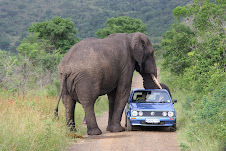.jpg)

